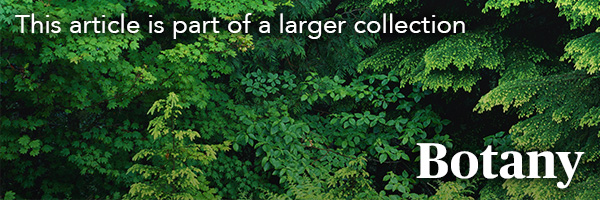Blue-green Algae
Blue-green Algae, now known as Cyanobacteria, are named for the blue-green pigment phycocyanin which along with chlorophyll a gives them a blue-green appearance. This led to Cyanobacteria being called blue-green algae before the kingdom Monera was recognized. Cyanobacteria share general prokaryotic characteristics (eg, they lack membrane-bound organelles such as a nucleus, chloroplasts and mitochondria) and so are related to bacteria; and include unicellular, colonial and filamentous forms.
In the marine environment some Cyanobacteria trap and bind together sediment while they simultaneously precipitate carbonate. As a result, structures called stromatolites are formed. Such structures are known from the Precambrian, when they freely populated large areas, probably because prior to 2 billion years ago, no grazing or boring organisms had evolved. When these organisms grew in numbers, stromatolite abundance declined rapidly.
Photosynthesis
Cyanobacteria were undoubtedly the first photosynthesizing organisms to evolve that produced oxygen, and so were responsible for the early accumulation of atmospheric oxygen. Many living species can photosynthesize under both aerobic and anaerobic conditions (oxygenic and anoxygenic photosynthesis). Under aerobic conditions, electrons for Photosystem I originate from Photosystem II, but under anaerobic conditions, in the presence of sulphur, electrons are derived from the reduction of sulphur (facultative phototrophic anaerobes).
Pigments
The pigment complex includes chlorophyll a, carotenoids (including some specific to this group, eg, oscillaxathin, myxoxanthophyll and aphanizophyll) and phycobiliprotein pigments which are water soluble chromoproteins assembled in macromolecular aggregate phycobilisomes, attached to the outer surface of the thylakoid membranes scattered throughout the cell.
Phycobiliproteins
Phycobiliproteins function in providing a cellular nitrogen reserve and in collecting light energy in photosynthesis. Concentrations of phycobiliproteins vary depending upon light quality and growth conditions. They play a role in chromatic adaptation. Within the cells are found myxophycean starch (glycogen granules); stored carbohydrate similar to amylopectin; cyanophycin granules which store protein as polypeptides; and polyphosphate bodies which contain phosphate.
Other Structural Characteristics
Surrounding many individual cells, filaments and colonies is a gelatinous sheath whose actual colour is dependent upon the prevailing environmental conditions (eg, in highly acidic or alkaline environments the sheath can be red or blue, respectively). Fimbriae or pili protrude from the cell walls of some species, and are probably involved in prokaryotic-eukaryotic cell interactions (eg, symbioses). Both cell wall structure and chemistry resembles that of gram-negative bacteria, but is more complex; the major wall component is peptidoglycan.
Reproduction
Cyanobacteria reproduce via cell division, while some filamentous species produce specialized vegetative fragments called hormogonia. These serve as vegetative propagules and possess a large number of gas vacuoles which make them buoyant, aiding in their dispersal.
Endospores and exospores are produced by some genera by internal division of the protoplast. In Dermocarpa, for example, an irregular mass of spores within the cell is produced, while in Chaemisiphon an external row of spores is produced. Resting spores called akinetes are also produced by some species in response to environmental stress.
Other filamentous members form heterocysts. These are larger than vegetative cells and serve as the production sites of the nitrogen-fixing enzyme nitrogenase. Evidence also exists for bacterium-like sexual reproduction (conjugation) and genetic recombination.
Locomotion
Many benthic (bottom dwelling) species can move over substrata in a gliding motion without apparent evident locomotory organs. Gliding occurs within the mucilage sheath, with this sheath sticking to the substratum and being left behind by the advancing filament. Regularly arranged fibrillar extensions of the protoplasm moving in waves against the sheath may be responsible for the propulsive force in gliding. In some species, gliding is accompanied by rotation of the filament.
Distribution and Habitat
This group of organisms is very widely distributed in many different and contrasting environments. They occur in water of varying salinity, nutrient status and temperature; with species found in both the benthos (seafloor organisms) and plankton; as well as aerial habitats, eg, damp soil and tree trunks. These organisms play an important role as primary colonizers in some lakes, in the establishment of soil flora and in the accumulation of humus.
In general, Cyanobacteria are more abundant in neutral or alkaline water but occur also in alkaline hot springs as well as the marine environment, particularly in plankton, where they comprise most of the picophytoplankton (tiny coccoid cells of Synechococcus and Synechcystis).
Blooms
In many nutrient-rich or eutrophic lakes, plankton Cyanobacteria often form very large summer or autumn populations which may acquire "bloom" proportions (eg, Anabaena spp, Microcystis aeruginosa, Aphanizomenon flos-aquae).
Toxicity
Some strains of Anabaena flos-aquae and Microcystis aeruginosa produce toxins which are poisonous to animals that drink the water. The ingested algae die in the digestive tract releasing toxins (eg, anatoxin - Aanabaena flos-aquae; saxitoxin - Microcystis aeuruginosa, Aphanizomenon flos-aquae). Saxitoxin is the same alkaloid responsible for paralytic shellfish poisoning. Cyanobacteria may be obligate phototrophs, facultative chemoheterotrophs or photoheterotrophs. Many species also form symbiotic relationships with a very diverse array of organisms, eg, with fungi (forming lichens), bryophytes (mosses and liverworts), ferns, seed plants and animals.

 Share on Facebook
Share on Facebook Share on X
Share on X Share by Email
Share by Email Share on Google Classroom
Share on Google Classroom

